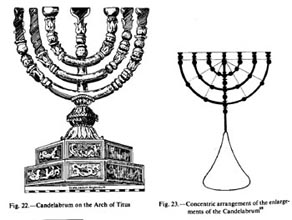Pi Day 2015 [3.14159]
To commemorate Pi Day, March 14th, 2015 we are recognizing the Creator’s usage of Pi in the Hebrew Tabernacle and Temple. 2015 holds a special Pi Day, since 3.14.15 is a once in a century event! We are happy to recognize this day by calling attention to the Creator’s application of the Pi ratio in some of the sacred furniture found within the inner and outer Temple/Tabernacle Courts. A portion of the material presented below is reprinted from my website study on “Pi in the Sky” @ try-god.com; [read more]. In a recent two Part Blog post, we discussed the Eastern Light through the Temple/Tabernacle, [read more] as an east-west axis line, where the people of Israel approached God in worship, a theme we will pick up in this study also. The first element on this line of access utilizing the Pi ratio is the round Brass Laver at the entrance to the inner court of the Tabernacle/ Temple. I Kings 7 below provides the descriptive details of this “molten sea.”
Figure 1. The Brasen Laver of Solomon’s Temple
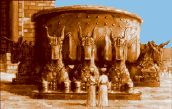
The Brass Laver in the Outer Court I Kings 7:23-30 23And he made a molten sea, ten cubits from the one brim to the other: it was round all about, and his height was five cubits: and a line of thirty cubits did compass it round about. 24And under the brim of it round about there were knops compassing it, ten in a cubit, compassing the sea round about: the knops were cast in two rows, when it was cast. 25 It stood upon twelve oxen, three looking toward the north, and three looking toward the west, and three looking toward the south, and three looking toward the east: and the sea was set above upon them, and all their hinder parts were inward. 26And it was an hand breadth thick, and the brim thereof was wrought like the brim of a cup, with flowers of lilies: it contained two thousand baths. 27And he made ten bases of brass; four cubits was the length of one base, and four cubits the breadth thereof, and three cubits the height of it. 28And the work of the bases was on this manner: they had borders, and the borders were between the ledges: 29And on the borders that were between the ledges were lions, oxen, and cherubims: and upon the ledges there was a base above: and beneath the lions and oxen were certain additions made of thin work. 30And every base had four brazen wheels, and plates of brass: and the four corners thereof had under-setters: under the laver were under-setters molten, at the side of every addition.
Figure 2. The Tabernacle of Moses Layout
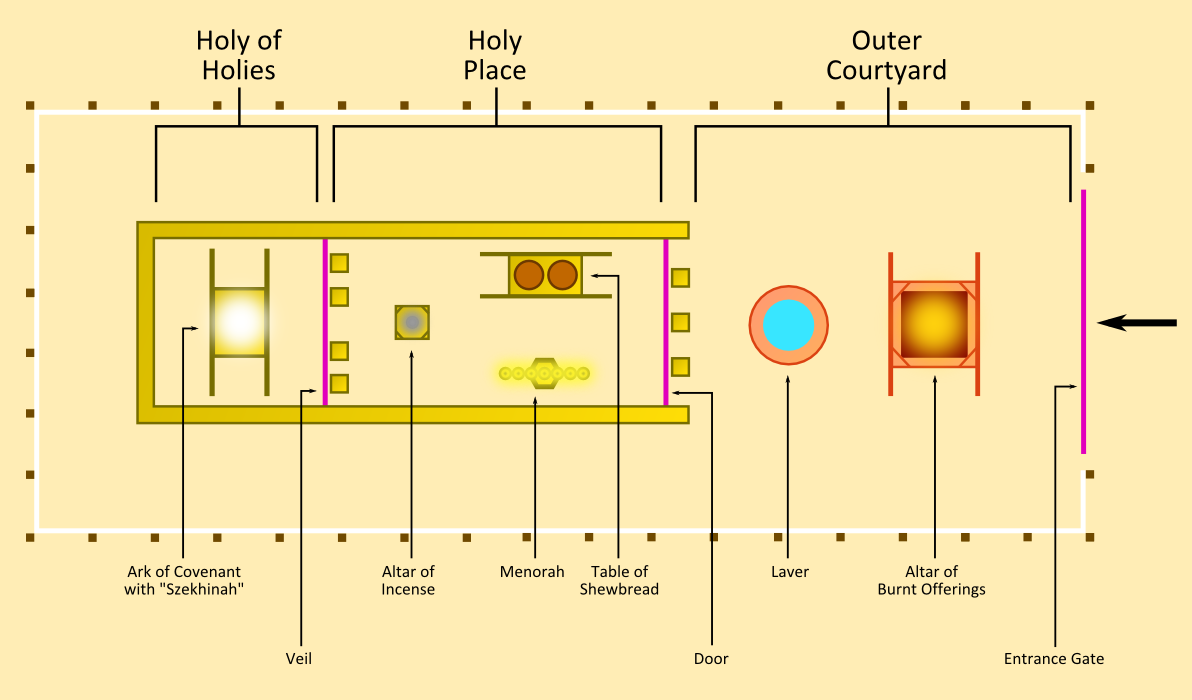
As we consider the Biblical usage of words related to how the pi ratio is revealed in Scripture, we will gain insight into the divine perspective of the Creator’s viewpoint on Pi, and His Intelligent Design of Creation. Anytime we can adopt the view of the Almighty through the truths He has shared with us in His matchless Word, it always speaks volumes to those of us who are paying attention. The Hebrew word for “line” of thirty cubits, in verse 23 is “qav” [*H6957]. The word carries the primary meaning of a measuring cord, a ruler, or standard of measure. We are also familiar with this concept by another term known as a “canon.” On the surface the Bible gives the basic mathematical value of pi here as 3, but the deeper truths of God’s Word lie below the surface, for those who have the heart and will to look for them. It is noteworthy that the first place where the pi ratio is applied by God in the Tabernacle and Hebrew Temple is in connection with the semi-circular Brass Laver in I Kings 7:23. Let’s take a look at some other places where this Hebrew word “qav” shows up. In the 38th chapter of Job, God is discussing the foundations of the Earth. The question in verse 5 asks: “Who hath laid the measures thereof, if you know? Or who hath stretched the line upon it?” The obvious Biblical answer to these questions is the Creator. In light of the usage of “qav” in I Kings 7:23, God’s exercise of Pi as a standard ruler or measure in laying and measuring the spherical dimensions and foundations of our planet, recorded in the book of Job, the oldest book of the Biblical Canon is enlightening. This is especially the case when we consider the context of Job 38, which deals with a series of questions about various elements of Creation, that only God Almighty could answer. The Intelligent Design specifications of the planet Earth would easily fall into this category, as to how the Earth’s spherical dimensions and temporal order fit into the celestial context of Creation. We can see the sense of this clarified even more in our next reference to the Hebrew word “qav.”
Figure 3. Planet Earth

In Psalm 19, The heavens declare the glory of God… Verse 4 says, “Their line is gone out through all the earth, and their words to the end of the world. In them He hath set a tabernacle for the sun.” Once again the Hebrew word for “line” here is qav. Let me ask you, what is the heavenly or celestial line that is a tabernacle, or provides the houses of the sun? The only sensible answer is the ecliptic! This is quite logical when we consider that the Israelites, during their 40-year sojourn in the Sinai wilderness were led by God, seen as a pillar of cloud during the day, and one of fire by night. The pillars dwelt over the Holy of the Holies in their Tabernacle, signifying the Creator’s personal presence among His people. When they camped during the evenings, Numbers 2 tells us they camped in the order of the tribes as it matched the order of the course of the sun on the ecliptic, (east, south, west, north). Israel’s twelve tribes, as we are aware by now, also matched up with the twelve signs of the zodiac in their God-ordained significance, before they were corrupted in heathen Astrology and mythology. This tribal order is also found in the twelve jewels of the High Priest’s breastplate, [Ex. 28:15-21]. Thus the celestial gospel originally related the story of the coming redeemer of mankind, that God wrote in the stars before He ever committed it to His Written Word. These are the words of Ps. 19:4 that have gone out through all the earth, unto the end of the world. This application of the Pi (the mathematical relation of the diameter of a circle to its circumference) by God, in reference to the circular ecliptic is certainly intriguing in light of the Sun’s apparent 360-degree path through its 12 houses of the zodiac, as viewed from Earth. In this light we should also be aware of the earlier context of I Kings 7.
Figure 4. 12 Signs of the Zodiac on the Ecliptic
The next aspect of the Temple layout relating to the Pi ratio concerns the two huge Brass Pillars at the entrance to the Hebrew Temple. These are described also in I Kings 7:13-15 below. 1 Ki 7:13 And king Solomon sent and fetched Hiram out of Tyre. [14] He was a widow’s son of the tribe of Naphtali, and his father was a man of Tyre, a worker in brass: and he was filled with wisdom, and understanding, and cunning to work all works in brass. And he came to king Solomon, and wrought all his work. [15] For he cast two pillars of brass, of eighteen cubits high apiece: and a line of twelve cubits did compass either of them about. The word for “line” in verse 15 above is not qav, as it is in verse 23, but it does indicate a line for measuring, thus a closer look at these brass pillars is still called for. As we know, Pi has long been considered a transcendental number, or constant of mathematics (3.14159….), linking a straight diameter to a curved circumference. The French archaeologist and mathematician Charles Funk-Hellet points out that: “Solomon had Hiram contribute to building a temple whose brass columns were 18 cubits high, and 12 cubits around. In other words, one cubit equaled the twelfth part of the circumference of the arc of 30 degrees, or pi/6. By subtracting the circumference from the height, they obtained 6 cubits in a straight line, which was equal to 1/2 circumference, or the exact value of pi; so that 1000 years before Christ the Hebrews knew that a cubit was a mathematical entity dependent on the circumference, and were able to resolve pi to four points of decimal.” 2 (emphasis mine)
Funk-Hellet’s observation that: “By subtracting the circumference from the height, they obtained 6 cubits in a straight line, which was equal to 1/2 circumference, or the exact value of pi/6.…“3 is worth remembering when we come to the subject of the celestial symbolism of the Menorah, and its application of pi, building on what we have found here. Funk-Hellet goes on to say that: “the Biblical cubit is equal to the Egyptian Royal cubit, which was incorporated into the Temple at Jerusalem as pi/6, or 523.6 millimeters. Using one unit of measure as the radius of a circle, the ancients found the trigonometric value of 30 degrees to be pi/6, (which divided the full circumference of the circle into 12 equal parts) and was the value of the royal cubit, or .5236 of the unit used: 3.1416/6 = .5236“4 (parenthesis & emphasis mine)
Figure 5. Solomon’s Temple with Brass Pillars at the Entrance
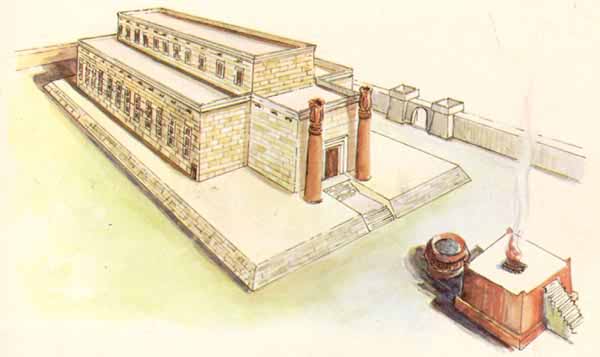
In effect, we have an architectural representation of the twelve-fold division of the heavens preserved in the dimensions of the Temple’s Brass columns, all based on the mathematical standard Pi, long before most modern scientists imagined the ancients knew anything about Pi at this level of accuracy. This provides more evidence showing the Creator’s perfect wisdom and Nature’s Great Geometer, at work in the dimensions of His Temple, as an illustration of heavenly realities [Heb. 8:5], which He gave to King David by revelation. Also symbolically contained in the dimensions of the Temple’s brass columns, is a figure of 12 calendar months of 30 days, totaling the 360 days of their year, a calendar also used going all the way back to Noah’s time, in the context of the 360-degrees of the ecliptic. This reveals the true origin of the 12 – 30° segments of the ecliptic, as a standard celestial measure, and also reveals the Pi ratio at the root of the Hebrew Calendar matching the 360 degrees of the circle with the 360 days of the year on the Calendar of the Biblical Patriarchs. And since Noah was already 600 years old when the Bible records the details of this luni-solar calendar in Genesis 7, it also implies that it was used by the earlier Biblical Patriarchs prior to the flood, and centuries before history and human science thought this level of sophisticated astronomical timekeeping was in use. For more information on Noah’s Calendar, [read more]. As we find in the above Biblical uses of the Hebrew word “qav,” God’s application of the Pi concept far exceeds any previous application in human history. Views based on scientific Materialism will never account fully for the realities of God’s Creation. Only from the Creator’s viewpoint in His Word, and the Works of His Hands, do these applications of pi make sense. Only He could apply pi to the ecliptic and the dimensions of our planet, a concept which is borne out in much greater detail, in how pi is symbolically and architecturally applied, not only in the Hebrew Tabernacle and Temple, but also in the Great Pyramid. Since the pattern shown to Moses for the Tabernacle was by divine revelation, just as the pattern of the Temple was shown to King David, these men of God did not calculate the blueprints for these sacred edifices, or their related measurements, by scientific trial and error. Thus they didn’t need to wait on the Greeks, like Archimedes, generally considered the greatest of ancient scientists, to rediscover them or to apply them in divine architecture. Although Archimedes is to be commended for his application of the pi proportion, respectfully it pales in comparison to what we find in the Biblical uses of “qav” relating to pi. For example, the third piece of furniture utilizing pi in the Tabernacle is the Menorah. Since it is located in the Inner Court or Holy Place, it is closer to the Holiest of All, the throne-room and dwelling place of God. When we consider the Menorah or candlestick we are primarily concerned with the original model exhibited in the Tabernacle of Israel. Later, in the Temple there were 10 candlesticks utilized in a different manner than at first. In (Figure 6.) below we see the first candlestick, or Menorah in the form of what James Strong has called a “stylized tree.” Strong gives his own description of Exodus 25:33 quoted below:
Ex. 25:33 Three bowls made like unto almonds, with a knop and a flower in one branch; and three bowls made like almonds in the other branch, with a knop and a flower: so in the six branches that come out of the candlestick.”
Strong’s geometric synopsis of this verse states:
“It will be perceived that each section of the semicircles of which these lines are the radii is composed of two members: the shank (a plain tube) and the bulb (or swell), and that each has a third part or base (a circular double flange, as a means of connection, hence an actual joint) only where it is united to a different kind of piece; i.e., at the bottom and top of the central shaft and of the six arms, including the intersections of the shaft with the arms.”5 [emphasis mine]
Figure 6. The Hebrew Menorah 6
When we apply what we have already seen in the Biblical teaching of the Sun’s dual symbolism, to the Menorah, it takes on a new light, associating the Sun not only with the solar system, but also the circular zodiac. The Menorah structure shows its central shaft as the foundation of the candle, since it holds the main light as the candle centerpiece. All the branches of the candlestick are attached to the central shaft, even as they obtain their light from the main candle. This pattern is mirrored in the solar system as the planets and moons do not generate their own light, but reflect the light of the Sun, as they orbit around it. We find not only the solar system order reflected here but also that of the ecliptic with 12 Constellations. This is evident in the Menorah’s semi-circular pattern based on pi. By expanding on Strong’s analysis of the Menorah this comes to light. In Strong’s smaller geometric model of the Menorah, we note bulbs on the six branches of the candlestick that are projections of the central bulb, where all the radiating geometric lines of the central light emanate. These projections of the central light on the six branches, (five naked eye planets and the Moon) depict how these luminaries reflect the Sun’s light in their individual orbits upon the Earth. This system reflects the temporal periods and orbits of each planet in our solar system, in relation to the Sun’s light. This is revealed first in the context of the mathematics of the base 60 standard, a primary trait of the Creator’s celestial order. Strong’s emphasis above on the geometric design of the Menorah, exhibits the Hebrew zodiac as in Genesis 49, with Jacob’s prophesies over his twelve sons. We should see that these lines noted by Strong as “the radii of the semi-circle,” reflecting the symbolic light of the world, if extended into a complete circle, the radii would divide it into 12 equal parts of 360 degrees of the circle according to pi. We can be safe in making this conceptual leap in the implied design of the Menorah, because we have just seen this pattern in the Temple pillars: Jachin and Boaz. This marks the Menorah as a complete symbolic piece of furniture in the Temple and Tabernacle, acting as a celestial symbol of the structure of both our solar system and the zodiac. It is complete because it is the third aspect we have observed utilizing pi measures, following on the great Brazen Sea and the Temple pillars. These aspects of The Celestial Symbolism of the Temple and Tabernacle; [read more] utilize pi to depict the Hebrew Calendar of 12 months of 30 days in the sacred 360-day year utilized by Noah. But the Menorah goes beyond this, embracing the planets in a heliocentric model of the ancient solar system, long before the Greek Aristarchus of Samos proposed it in the second century BC. The Menorah’s [read more] implicit use of the pi ratio incorporates the previous usage of this principle in the Brasen Sea and the Temple pillars, while adding the symbolism of the heliocentric solar system to these previous applications, all incorporated into a single model. According to conventional history, the idea of a heliocentric “universe” or solar system, originated with the ancient Greeks, specifically Aristarchus of Samos as mentioned above. This idea however, did not catch on in a big way until Copernicus, who while reviewing some of Aristarchus’ ideas seized upon this concept and ran with it. He did this at his own peril due to the prevailing worldview of the time, especially that of the Roman Catholic Church, based on a geocentric view of the solar system espoused by Ptolemy, which held sway in intellectual and religious circles for over 1500 years. In the Figure 7. graphic below from Harmonica Macrocosmica [A. Cellarius, Amsterdam 1660] depicts a Sun-centered Copernican view of the cosmos.
Figure 7. Heliocentric Solar System 7

This aspect of pi as it applies to Biblical cosmology will show the idea of a heliocentric “universe” predating the 2nd Century BC and Aristarchus, by at least 1300 years, and its genuine roots are found in the Old Testament Scriptures. Our present tour through the Hebrew Taberncale/Temple not only reveals this, but even deeper truths as the Menorah’s complete symbolic nature is revealed, leading to the holiest of all with the Ark of the Covenant, and the Holy Names of God. The pi ratio in I Kings 7, should also be considered with any practical application of pi in King Solomon’s day. On this subject there is information concerning a practical approximation of pi in the ancient world, based on septenary units of measure. In some ancient traditions, the relation of the Diameter to the Circumference, embodied in pi, symbolized the names of God; Elohim and Jehovah. With Elohim, the Creator representing the Circumference, of the curved line – the totality of His Creation, and in Jehovah, the straight line Diameter, or God in relationship to His Creation, thus pi embodies some geometrical expressions of the Almighty. We find the basic elements of the concept of “squaring the circle” in the Circle’s diameter inscribed in the circumference of a surrounding Sphere inside a Cube, in I Kings 7:30 above, contained in the square base containing the circular brasen sea. This principle has survived through the centuries in the domed sacred architecture of many temples and churches, where the circular dome is surrounded by a square building. We should take note that the Holy of the holies, containing the Ark of the Covenant, was a perfect cube, contained within a double-square ground-plan of the Hebrew Tabernacle. This provided the divine foundation of many practices in the “sacred geometry” of the secular world. The practical approximation of pi in the ancient world of sacred architecture, has preserved this concept of the Creator God in relation to His Creation, in a systematic application of principles of sacred geometry, based on septenary units of measure. According to Stechini, in this system the; “circumference was considered 22/7 of the diameter; this approximation of pi rendered (3 1/7, or 3.142857) is still in use today as an adequate approximation in many problems of engineering.” 8 As Beckmann points out, “Archimedes started with a hexagon and progressively doubling the number of sides he arrived at a polygon of 96 sides, which yielded pi as 3 1/7, or 3.142857.” 9
The importance of relating pi to septenary units is obvious in a Biblical light when we consider God’s abundant use of the number 7 in His ordering of Creation, including the Menorah. Some of this evidence is covered in our website essay on the Calendar of the Israel, [read more]. This ratio of 22/7 is also intriguing because it expresses the ratio between the 22 letters of the Hebrew alphabet, in relation to its seven vowels. This is a supporting factor in the idea that the roots of writing and the first alphabet originate in the Celestial Gospel. As the first “written” revelation to mankind, the stars in this gospel were named and numbered by God [Ps. 147:4]. The divine message of the coming redeemer and the means God chose to deliver it, thus provide the sacred foundation of all language and mathematics. As the divine original source of this wisdom, the witness of the stars was above reproach. The pi ratio expressed as 22/7, reflects this perfection of the celestial gospel, in at least the mathematical, geometrical and linguistic contexts. Let’s now consider a final point linked with septenary measuring units. This note from Keil and Delitzsch’ Commentary on I Kings 7:23 below, adds support to the application of pi relating to septenary units as seen in the brazen sea above, [3.142857] and the ancient knowledge of its use in Israel, via revelation from God, in the dimensions of the Tabernacle, Temple and its sacred furniture. “The brazen sea (cf. 2Ch. 4:2-5). – “He made the molten sea – a water-basin called יָם (mare) on account of its size – ten cubits from the one upper rim to the other,” i.e., in diameter measured from the upper rim to the one opposite to it, “rounded all round, and five cubits its (external) height, and a line of thirty cubits encircled it round about,” i.e., it was thirty cubits in circumference. The Chethib קוה is to be read קָוֶה here and in Zech. 1:16 and Jer. 31:39, for which the Keri has קָו in all these passages. קָוֶה or קָו means a line for measuring, which is expressed in 1Ki. 7:15 by חוּט. The relation of the diameter to the circumference is expressed in whole numbers which come very near to the mathematical proportions. The more exact proportions would be as 7 to 22, or 113 to 355.”10 [emphasis mine]
Figure 8. The Ark of the Covenant
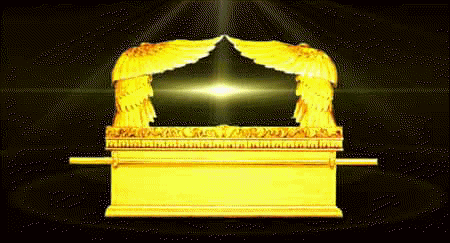
The septenary relation to pi uncovers the link between the pi and phi ratios, through the popular Fibonacci Series. This is interesting when we consider that the dimensions of Ark of the Covenant conform to the phi standard, in the holiest of all. Since the lid or “mercy seat” of the Ark represents the Creator’s Throne, we not only find the geometric application of the Names of God: Jehovah/Elohim in practice by the Nation of Israel, as they worship the Almighty according to the tenets of Scripture, but the measures of the Ark are based on a 1×2 rectangle [Ex. 25:10] that perfectly conforms the phi ratio as seen in the Coffer of the Kings Chamber in the Great Pyramid. This link between phi and pi makes it possible to obtain pi without the need for measuring! This is illustrated in the following quote from Livio Stechini: “It is possible to use the Fibonacci Series to obtain an accurate relation for the diameter of the circle to its circumference, without recourse to pi. In the Fibonnacci series of 21, 34, 55, if 21 is taken as the diameter of a circle, its circumference will be 55 x 6/5 = 66, accurate to the one thousandth part, giving the Great Pyramid value of pi as 22/7 = 3.142857. Higher numbers in the fibonacci series provide increasingly finer values in whole numbers accurate to one ten-thousandth part. Prolonging the series to 80, 144, 233, 377, 610… a diameter of 144 (4 x 576) gives a circumference of 377 x 6/5 or a pi value of 3.1415. A diameter of 233= a circumference of 610 x 6/5 or a pi value of 3.1416…”11
Since the phi principle inherent in the Fibonacci Series is the basis of the precepts of geometric growth life throughout the plant and animal kingdoms of life evident in the Creator’s Four Kingdoms of Life, [read more] this principle of mathematics is elevated above that of pi. As the Creator and ultimate Source of Life, the Almighty has led us on this path of spiritual discovery paved with the principles of geometric and mathematical truth revealed in God’s Word. This is the geometric progression we have just witnessed in our pi journey through the Tabernacle/ Temple of Israel, on this day memorializing Pi.
Footnotes
1. Strong’s Concordance, James Strong, notes on [H6957]
2. Secrets of the Great Pyramid, Peter Thompkins, p. 263
3. IBID p. 16.
4. IBID
5. The Tabernacle of Israel, James Strong
6. IBID [picture credit]
7. Harmonica Macrocosmica, Amsterdam, 1660
8. Secrets of the Great Pyramid, Peter Thompkins,
9. A History of Pi, Petr Beckmann. p. 64
10. KEIL & DELITSCH Commentary on I Kings 7:23.
11. Secrets of the Great Pyramid, Peter Thompkins, p. 97 fn


